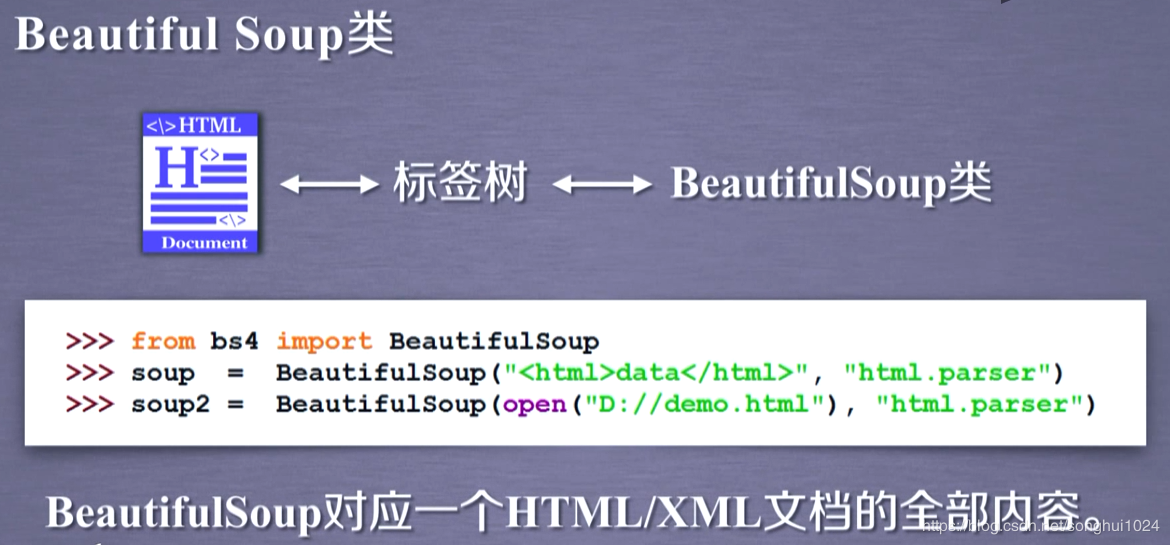Beautiful Soup4库入门
一、Beautiful Soup简介
Python拥有出色的内置HTML解析器模块——HTMLParser,
然而还有一个功能更为强大的HTML或XML解析工具——BeautifulSoup(美味的汤),它是一个第三方库。简单来说,BeautifulSoup最主要的功能是从网页抓取数据。
Beautiful Soup库是解析、遍历、维护“标签树”的功能库。

解析器有:html.parser, lxml, xml, html5lib

BeautifulSoup官方推荐使用lxml
推荐使用lxml作为解析器,因为效率更高. 在Python2.7.3之前的版本和Python3中3.2.2之前的版本,必须安装lxml或html5lib, 因为那些Python版本的标准库中内置的HTML解析方法不够稳定.
格式化显示:soup.prettify(),自动为标签间添加换行符。
bs4将读入的文件或者字符串转换为"utf-8"。
二、安装Beautiful Soup库:
管理员方式打开CMD输入
pip install beautifulsoup4
建议同时安装"lxml"模块,BeautifulSoup支持Python标准库中的HTML解析器(HTMLParser),还支持一些第三方的解析器,如果我们不安装它,则 Python 会使用 Python默认的解析器,lxml 解析器更加强大,速度更快,推荐安装
pip install lxml
小测试:
from bs4 import BeautifulSoup html = '<html><head>aaaaa</head><body>bbb</body></html>' soup = BeautifulSoup(ht, 'lxml') print(soup.prettify()) #soup.prettify()格式化显示
输出结果为:
<?xml version="1.0" encoding="utf-8"?> <html> <head> aaaaa </head> <body> bbb </body> </html>
三、BeautifulSoup四大对象类型介绍
BeautifulSoup将复杂HTML文档转换成一个复杂的树形结构,每个节点都是Python对象,所有对象可以归纳为4种:
- Tag(标签)
- NavigableString(内容)
- BeautifulSoup(文档)
- Comment(注释)
1.Tag类型
即HTML的整个标签,如获取<title>标签:
print(soup.title) #<title>AAA</title>
Tag有两个重要属性:name,attrs。
①name:HTML的标签名称:
print(soup.name) #[document] print(soup.head.name) #head
②attrs:标签属性字典:
print(soup.p.attrs) #{'class': ['title'], 'name': 'dromouse'}
如果想要单独获取某个属性:
print(soup.p['class']) #['title_class']
2.NavigableString类型
既然我们已经得到了整个标签,那么问题来了,我们要想获取标签内部的文字内容怎么办呢?很简单,用 string 即可:
print(soup.p.string) #ppppppp
3.BeautifulSoup类型
BeautifulSoup 对象表示的是一个文档的全部内容.:
print(soup.name) # [document]
4.Comment类型
HTML的注释内容,注意的是,不包含注释符号。我们首先判断它的类型,是否为 Comment 类型,然后再进行其他操作,如打印输出:
if type(soup.a.string)==bs4.element.Comment: print(soup.a.string) #<!-- Elsie -->
四、遍历文档树
1.遍历子节点(下行遍历)
①contents:获取所有子节点(仅仅获取儿子),返回列表:
print(soup.head.contents) #[<title>The Dormouse's story</title>]
②children:获取所有子节点(仅仅获取儿子),返回列表生成器,用于遍历
for child in soup.body.children: print(child)
③descendants:获取所有子孙节点(获取全部子孙后代),返回列表生成器,用于遍历
for child in soup.body.descendants: print(child)
2.遍历父节点(上行遍历)
①parent:返回某节点的直接父节点(仅仅获取父亲):
p = soup.p print(p.parent.name) #body
②parents:返回某节点的所有父辈及以上辈的节点(父亲的父亲的父亲....都获取):
content = soup.head.title.string for parent in content.parents: print(parent.name) ## 结果 title head html [document]
3.遍历兄弟节点(平行遍历)
①next_sibling:获取该节点的下一个兄弟节点,结果通常是字符串或空白,因为空白或者换行也可以被视作一个节点。
②previous_sibling:获取该节点的上一个兄弟节点。
print(soup.p.next_sibling) # 实际该处为空白 print(soup.p.prev_sibling) #None 没有前一个兄弟节点,返回 None
③next_siblings:迭代获取该节点之前的全部兄弟节点。
③next_siblings:迭代获取该节点之后的全部兄弟节点。
4.遍历(获取)节点内容
①string:返回单个文本内容。
如果一个标签里面没有标签了,那么 string 就会返回标签里面的内容。
如果标签里面只有唯一的一个标签了,那么 string 也会返回最里面的内容。
如果tag包含了多个子节点,tag就无法确定,string 方法应该调用哪个子节点的内容,string 的输出结果是 None。
print(soup.head.string) print(soup.title.string) #head内容 #title内容 print(soup.html.string) # None
②strings:返回当前节点以下的所有文本内容,返回列表生成器,用于遍历,且包含空行和空格。
for string in soup.html.strings: print(string)
③stripped_strings:返回当前节点以下的所有文本内容,返回列表生成器,用于遍历,且不包含空行和空格。
五、搜索文档树
1.find_all(name=None, attrs={}, recursive=True, text=None, limit=None, **kwargs)
find_all()方法搜索当前tag的所有tag子节点,并判断是否符合过滤器的条件。
参数说明:
①name参数
name参数很强大,可以传多种方式的参数,查找所有名字为 name 的tag,字符串对象会被自动忽略掉。
(a)传标签名:最简单的过滤器是标签名。在搜索方法中传入一个标签名参数,BeautifulSoup会查找与标签名完整匹配的内容;返回结果列表,列表中的元素仍然是BeautifulSoup对象
print(soup.find_all('a')) #[<a class="sister" href="http://example.com/elsie" rel="external nofollow" id="link1"><!-- Elsie --></a>, <a class="sister" href="http://example.com/lacie" id="link2">Lacie</a>, <a class="sister" href="http://example.com/tillie" id="link3">Tillie</a>]
(b)传正则表达式:如果传入正则表达式作为参数,BeautifulSoup会通过正则表达式的 match() 来匹配内容。下面例子中找出所有以b开头的标签,这表示<body>和<b>标签都应该被找到:
import re for tag in soup.find_all(re.compile("^b")): print(tag.name) # body # b
(c)传列表:如果传入列表参数,BeautifulSoup会将与列表中任一元素匹配的内容返回。下面代码找到文档中所有<a>标签和<b>标签:
soup.find_all(["a", "b"]) # [<b>The Dormouse's story</b>, # <a class="sister" href="http://example.com/elsie" rel="external nofollow" id="link1">Elsie</a>, # <a class="sister" href="http://example.com/lacie" rel="external nofollow" id="link2">Lacie</a>,]
(d)传True:True 可以匹配任何值,下面代码查找到所有的tag,但是不会返回字符串节点:
for tag in soup.find_all(True): print(tag.name) # html # head # title # body # p # b # p # a # a
(e)传函数:如果没有合适过滤器,那么还可以定义一个方法,方法只接受一个元素参数。如果这个方法返回 True 表示当前元素匹配并且被找到,如果不是则反回 False:
def has_class_but_no_id(tag): return tag.has_attr('class') and not tag.has_attr('id') soup.find_all(has_class_but_no_id) # [<p class="title"><b>The Dormouse's story</b></p>, # <p class="story">Once upon a time there were...</p>, # <p class="story">...</p>]
②keyword参数
注意的是,如果一个指定名字的参数不是搜索内置的参数名,搜索时会把该参数当作指定名字tag的属性来搜索,如果包含一个名字为 id 的参数,BeautifulSoup会搜索每个tag的”id”属性:
soup.find_all(id='link2') # [<a class="sister" href="http://example.com/lacie" rel="external nofollow" id="link2">Lacie</a>]
如果传入 href 参数,Beautiful Soup会搜索每个tag的"href"属性:
soup.find_all(href=re.compile("elsie")) # [<a class="sister" href="http://example.com/elsie" rel="external nofollow" id="link1">Elsie</a>]
使用多个指定名字的参数可以同时过滤tag的多个属性:
soup.find_all(href=re.compile("elsie"), id='link1') # [<a class="sister" href="http://example.com/elsie" rel="external nofollow" id="link1">three</a>]
在这里我们想用 class 过滤,不过 class 是 python 的关键词,这怎么办?加个下划线就可以:
soup.find_all("a", class_="sister") # [<a class="sister" href="http://example.com/elsie" rel="external nofollow" id="link1">Elsie</a>, # <a class="sister" href="http://example.com/lacie" rel="external nofollow" id="link2">Lacie</a>, # <a class="sister" href="http://example.com/tillie" rel="external nofollow" id="link3">Tillie</a>]
③attrs参数
有些tag属性在搜索不能使用,比如HTML5中的 " data-* " 自定义属性:
data_soup = BeautifulSoup('<div data-foo="value">foo!</div>') data_soup.find_all(data-foo="value") # SyntaxError: keyword can't be an expression ## 但是可以通过 find_all() 方法的 attrs 参数定义一个字典参数来搜索包含特殊属性的tag data_soup.find_all(attrs={"data-foo": "value"}) # [<div data-foo="value">foo!</div>]
④text参数
通过 text 参数可以搜搜文档中的字符串内容。与 name 参数的可选值一样,text 参数接受字符串 、正则表达式 、列表、True。
soup.find_all(text="Elsie") # [u'Elsie'] soup.find_all(text=["Tillie", "Elsie", "Lacie"]) # [u'Elsie', u'Lacie', u'Tillie'] soup.find_all(text=re.compile("Dormouse")) # 模糊查找 [u"The Dormouse's story", u"The Dormouse's story"]
⑤limit参数
find_all() 方法返回全部的搜索结构,如果文档树很大那么搜索会很慢。如果我们不需要全部结果,可以使用 limit 参数限制返回结果的数量。效果与SQL中的limit关键字类似,当搜索到的结果数量达到 limit 的限制时,就停止搜索返回结果。
soup.find_all("a", limit=2) # [<a class="sister" href="http://example.com/elsie" rel="external nofollow" id="link1">Elsie</a>, # <a class="sister" href="http://example.com/lacie" rel="external nofollow" id="link2">Lacie</a>]
⑥recursive参数
调用tag的 find_all() 方法时,BeautifulSoup会检索当前tag的所有子孙节点,如果只想搜索tag的直接子节点(只要儿子),可以使用参数 recursive=False。
soup.html.find_all("title") # [<title>The Dormouse's story</title>] soup.html.find_all("title", recursive=False) # []
2.find( name , attrs , recursive , text , **kwargs )
它与 find_all() 方法唯一的区别是 find_all() 方法的返回结果是值包含一个元素的列表,而 find() 方法直接返回结果。
3.find_parents() 和 find_parent()
find_all() 和 find() 只搜索当前节点的所有子节点,孙子节点等。find_parents() 和 find_parent() 用来搜索当前节点的父辈节点,搜索方法与普通tag的搜索方法相同,搜索文档搜索文档包含的内容。
4.find_next_siblings() 和 find_next_sibling()
这2个方法通过 .next_siblings 属性对当 tag 的所有后面解析的兄弟 tag 节点进行迭代, find_next_siblings() 方法返回所有符合条件的后面的兄弟节点,find_next_sibling() 只返回符合条件的后面的第一个tag节点。
5.find_previous_siblings() 和 find_previous_sibling()
这2个方法通过 .previous_siblings 属性对当前 tag 的前面解析的兄弟 tag 节点进行迭代, find_previous_siblings() 方法返回所有符合条件的前面的兄弟节点,find_previous_sibling() 方法返回第一个符合条件的前面的兄弟节点。
6.find_all_next() 和 find_next()
这2个方法通过 .next_elements 属性对当前 tag 的之后的 tag 和字符串进行迭代, find_all_next() 方法返回所有符合条件的节点, find_next() 方法返回第一个符合条件的节点。
7.find_all_previous() 和 find_previous()
这2个方法通过 .previous_elements 属性对当前节点前面的 tag 和字符串进行迭代,find_all_previous() 方法返回所有符合条件的节点, find_previous()方法返回第一个符合条件的节点。
六、CSS选择器
我们在写 CSS 时,标签名不加任何修饰,类名前加点,id名前加 #,在这里我们也可以利用类似的方法来筛选元素,用到的方法是 soup.select(),返回类型是 list。
1、通过标签名查找
print soup.select('title') #[<title>The Dormouse's story</title>] print soup.select('a') #[<a class="sister" href="http://example.com/elsie" rel="external nofollow" id="link1"><!-- Elsie --></a>, <a class="sister" href="http://example.com/lacie" id="link2">Lacie</a>, <a class="sister" href="http://example.com/tillie" rel="external nofollow" id="link3">Tillie</a>] print soup.select('b') #[<b>The Dormouse's story</b>]
2、通过类名查找
print soup.select('.sister') #[<a class="sister" href="http://example.com/elsie" rel="external nofollow" id="link1"><!-- Elsie --></a>, <a class="sister" href="http://example.com/lacie" rel="external nofollow" id="link2">Lacie</a>, <a class="sister" href="http://example.com/tillie" rel="external nofollow" rel="external nofollow" rel="external nofollow" id="link3">Tillie</a>]
3、通过 id 名查找
print soup.select('#link1') #[<a class="sister" href="http://example.com/elsie" rel="external nofollow" rel="external nofollow" id="link1"><!-- Elsie --></a>]
4、组合查找
组合查找即和写 class 文件时,标签名与类名、id名进行的组合原理是一样的,例如查找 p 标签中,id 等于 link1的内容,二者需要用空格分开。
print soup.select('p #link1') #[<a class="sister" href="http://example.com/elsie" rel="external nofollow" rel="external nofollow" id="link1"><!-- Elsie --></a>]
5、直接子标签查找
print soup.select("head > title") #[<title>The Dormouse's story</title>]
6、属性查找
查找时还可以加入属性元素,属性需要用中括号括起来,注意属性和标签属于同一节点,所以中间不能加空格,否则会无法匹配到。
print soup.select('a[class="sister"]') #[<a class="sister" href="http://example.com/elsie" rel="external nofollow" id="link1"><!-- Elsie --></a>, <a class="sister" href="http://example.com/lacie" rel="external nofollow" rel="external nofollow" id="link2">Lacie</a>, <a class="sister" href="http://example.com/tillie" id="link3">Tillie</a>] print soup.select('a[href="http://example.com/elsie" rel="external nofollow" rel="external nofollow" rel="external nofollow" ]') #[<a class="sister" href="http://example.com/elsie" rel="external nofollow" rel="external nofollow" id="link1"><!-- Elsie --></a>]
同样,属性仍然可以与上述查找方式组合,不在同一节点的空格隔开,同一节点的不加空格:
print soup.select('p a[href="http://example.com/elsie" rel="external nofollow" ]') #[<a class="sister" href="http://example.com/elsie" rel="external nofollow" rel="external nofollow" id="link1"><!-- Elsie --></a>]
以上的 select 方法返回的结果都是列表形式,可以遍历形式输出,然后用 string或get_text() 方法来获取它的内容:
soup = BeautifulSoup(html, 'lxml') print type(soup.select('title')) print soup.select('title')[0].get_text() for title in soup.select('title'): print title.get_text()






【推荐】国内首个AI IDE,深度理解中文开发场景,立即下载体验Trae
【推荐】编程新体验,更懂你的AI,立即体验豆包MarsCode编程助手
【推荐】抖音旗下AI助手豆包,你的智能百科全书,全免费不限次数
【推荐】轻量又高性能的 SSH 工具 IShell:AI 加持,快人一步
· AI与.NET技术实操系列:向量存储与相似性搜索在 .NET 中的实现
· 基于Microsoft.Extensions.AI核心库实现RAG应用
· Linux系列:如何用heaptrack跟踪.NET程序的非托管内存泄露
· 开发者必知的日志记录最佳实践
· SQL Server 2025 AI相关能力初探
· winform 绘制太阳,地球,月球 运作规律
· AI与.NET技术实操系列(五):向量存储与相似性搜索在 .NET 中的实现
· 超详细:普通电脑也行Windows部署deepseek R1训练数据并当服务器共享给他人
· 【硬核科普】Trae如何「偷看」你的代码?零基础破解AI编程运行原理
· 上周热点回顾(3.3-3.9)